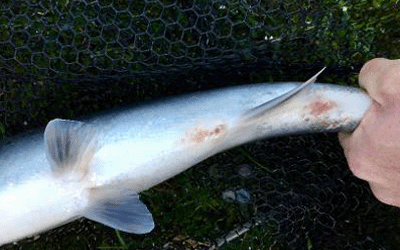There are a number of diseases which have the potential to impact wild fish. Fungal infections in freshwater, particularly when water temperatures are low are relatively common, and can be serious, whereas other diseases, such as Ulcerative Dermal Necrosis (UDN) or Infectious Salmon Anaemia (ISA) can be devastating.
Whilst certain diseases can be observed when salmon are in the freshwater environment, in the marine phase of the lifecycle detection of disease in wild fish is extremely challenging and therefore there is little knowledge of the extent of this pressure. Whilst all of these diseases occur in the natural environment, there is also the potential for transfer of certain diseases between farmed and wild fish. For this reason, some notifiable diseases require immediate action on farms.
How to help us
Fisheries Management Scotland are liaising with our members and Marine Scotland to understand the extent of fish health and disease issues as they arise. As part of this process we have developed an app to facilitate the collection of data submitted by anglers and others through the relevant district salmon fishery board. If you wish to report information, submit any information and images through our app below. We are aware of issues when uploading images into the app from iphone – see our simple guidance to resolve this issue.
New guidance
In light of the increasing reports of this issue, a new publication Red Skin Disease in wild Atlantic salmon – a severity field guide has been jointly produced by Marine Scotland Science, the Environment Agency, Natural Resources Wales and Inland Fisheries Ireland. The field guide has been produced to standardise clinical reporting of RSD-like lesions to support ongoing monitoring of this condition across salmon rivers. It also serves to distinguish this emerging condition from other, frequently observed skin lesions in migratory salmonids.
Saprolegnia
In the last few years we have received a number of reports of salmon and sea trout exhibiting fungal infections. Saprolegnia causes white, cream or pale brown cotton wool-like growths on the skin and fins of fish. These infections often start as small round patches, but can increase in size to form larger plaques covering the body.
It is not unusual for salmon and sea trout to develop Saprolegnia infections as they enter rivers from the sea. Light infections may look unsightly but are usually tolerated by healthy fish and can heal if conditions allow. These infections have little effect on fish health and infected salmon and sea trout can continue to spawn successfully. In some cases Saprolegnia infections can persist and may increase in size over time. Heavy infections can cause severe skin damage, leading to debilitation, lethargy and even mortality of badly infected fish.
Red Skin Disease (RSD)
Since 2019, Fisheries Management Scotland has been receiving reports of Atlantic salmon exhibiting signs of red ‘rash’, bleeding and/or ulceration. We are also aware of similar reports from Ireland and Norway. The Fish Health Inspectorate has been monitoring the situation, however reports from the sampling of fish have been inconclusive. Fisheries Management Scotland are liaising closely with Marine Scotland on this issue and we have produced an information sheet with some frequently asked questions.
Red Vent Syndrome
Reports of wild Atlantic salmon (Salmo salar) returning to Scottish rivers with inflamed, swollen bleeding vents were first received in early June 2007. By the end of the year over 50 rivers in Scotland reported the presence of red vent syndrome with similar observations received from rivers in England and Wales. Marine Scotland have produced a topic sheet entitled Red Vent Syndrome in Wild Atlantic Salmon.
View our interactive dashboard below

